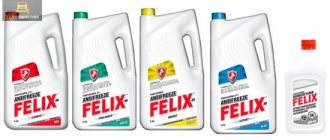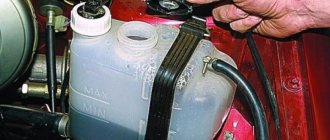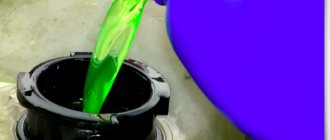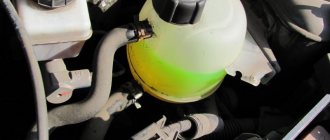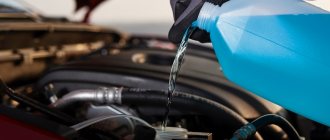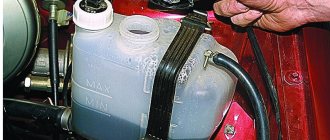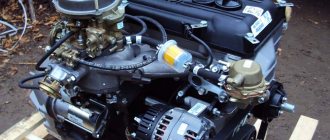| Year | Engine | Type | Color | Lifetime | Recommended Manufacturers |
| 1987 | for all | TL | blue | 2 years | Felix, Prompek, Speedol Super Antifreez, Sapfire, Antifreeze-40 |
| 1988 | for all | TL | blue | 2 years | Lukoil Super A-40, AGA-L40, Sapfire, Antifreeze-40 |
| 1989 | for all | TL | blue | 2 years | Alaska A-40M, AGA-L40, Sapfire |
| 1990 | for all | TL | blue | 2 years | Felix, AGA-L40, Speedol Super Antifreeze, Sapfire |
| 1991 | for all | TL | blue | 2 years | Lukoil Super A-40, Tosol-40, Speedol Super Antifriz, Sapfire |
| 1992 | for all | TL | blue | 2 years | Antifreeze-40, AGA-L40, Speedol Super Antifriz, Anticongelante Gonher HD |
| 1993 | for all | G11 | green | 3 years | Glysantin G 48, Lukoil Extra, Aral Extra, Mobil Extra, Zerex G, EVOX Extra, Genantin Super |
| 1994 | for all | G11 | green | 3 years | Lukoil Extra, Zerex G, Castrol NF, AWM, GlycoShell, Genantin Super |
| 1995 | for all | G11 | green | 3 years | Glysantin G 48, Havoline AFC, Nalcool NF 48, Zerex G |
| 1996 | for all | G11 | green | 3 years | Mobil Extra, Aral Extra, Nalcool NF 48, Lukoil Extra, Castrol NF, GlycoShell |
| 1997 | for all | G11 | green | 3 years | AWM, EVOX Extra, GlycoShell, Mobil Extra |
| 1998 | for all | G11 | green | 3 years | Havoline AFC, Aral Extra, Mobil Extra, Castrol NF, AWM |
| 1999 | for all | G11 | green | 3 years | Aral Extra, Genantin Super, G-Energy NF |
| 2000 | for all | G12 | red | 5 years | GlasElf, AWM, MOTUL Ultra, G-Energy, Freecor |
| 2001 | for all | G12 | red | 5 years | Castrol SF, G-Energy, Freecor, Lukoil Ultra, GlasElf |
| 2002 | for all | G12 | red | 5 years | Freecor, AWM, MOTUL Ultra, Lukoil Ultra |
| 2003 | for all | G12 | red | 5 years | Lukoil Ultra, Motorcraft, Chevron, AWM |
| 2004 | for all | G12 | red | 5 years | MOTUL Ultra, MOTUL Ultra, G-Energy |
| 2005 | for all | G12+ | red | 5 years | Chevron, AWM, G-Energy, Lukoil Ultra, GlasElf |
| 2006 | for all | G12+ | red | 5 years | Chevron, G-Energy, Freecor |
For diesel and gasoline engines the parameters will be the same!
When purchasing, you need to know the shade - Color and Type of antifreeze allowed for the year of manufacture of your 2109. Select the manufacturer at your discretion. Do not forget - each type of liquid has its own service life.
For VAZ 2109 (1st generation) 1987, with any type of engine, the traditional class of antifreeze, type TL or antifreeze with shades of blue is suitable. The approximate period of the next replacement will be 2 years.
If possible, check the selected fluid against the vehicle manufacturer's specifications and service intervals.
Each type of liquid has its own color. There are rare cases when the type is tinted with a different color. The color of red antifreeze can be from purple to light pink (green and yellow have the same principles).
Replacing antifreeze on a VAZ 2107: instructions and photos
The engine cooling system is an important part of every car, through which the normal operation of the engine is ensured. A significant part of the cooling system is devoted to refrigerant or coolant, which can be presented in the form of antifreeze (in most cases), antifreeze or distilled water.
During the operation of any car, including the VAZ 2107, it is important to promptly replace the coolant, which will improve the efficiency of the cooling system. In this issue, we will look in more detail at how to correctly replace antifreeze on a VAZ 2107, what is required for this and where to start.
Application of antifreeze
Antifreeze is a whole group of coolants developed by large foreign companies. This composition differs from water not only in its changed freezing threshold and boiling point. Thermal expansion when exposed to cold for antifreeze is 1.5%, while water has 9%. Ethylene glycol-based fluids are most widespread, and the addition of additives has helped to significantly improve their properties.
Rationing of coolants is carried out on the basis of GOST 28084-89, but its requirements do not regulate the composition and quantity of additives. Most countries have their own government regulations, and the production of antifreeze is carried out based on their recommendations. In addition to the existence of GOSTs, various specifications are used, on the basis of which temperature limits are indicated.
Instructions for replacing antifreeze
Antifreeze, compared to water, is quite resistant to frost - it does not freeze. It is also not a source of scale, which means it does not clog the cooling system.
But, subjected to constant temperature influences and fluctuations, antifreeze loses its properties during operation:
For these reasons, it is necessary to change antifreeze at least once every six months. It is important to do this during seasonal car maintenance. Timely replacement of coolant will help avoid unpleasant consequences, unwanted repairs and unnecessary waste of money.
So, replacing antifreeze on a VAZ 2107 includes draining the antifreeze, flushing the cooling system (if necessary) and replacing the used coolant with new antifreeze or antifreeze.
You should first prepare the following materials and tools:
Drain
Draining antifreeze from the VAZ 2107 tank includes the following sequence of actions:
Flushing
Flushing the cooling system is an important procedure. It determines how effectively the VAZ 2107 engine will be cooled. A number of car owners believe that flushing the cooling system is a waste of time, and immediately fill in new antifreeze or antifreeze after draining the used fluid. This causes clean and dirty fluid to mix, negatively affecting performance.
You can flush the cooling system using either water or special products.
Cleaning OS with water
Flushing the cooling system with water is only allowed if there is no flushing liquid. The fact is that ordinary water contains impurities that contribute to the formation of scale. If the choice is water, it is better to use distilled water.
Sequencing:
Cleaning the OS with a special agent
You can also flush the cooling system with a product containing special impurities. This is a more expensive way to clean the system, but in the long term the most appropriate option, since the product removes from the tank:
Today, VAZ 2107 car owners use flushing fluids, the two main components of which are acids and alkalis. Car owners prefer LAVR, which costs from 700 rubles.
The sequence of actions when flushing the cooling system with a special liquid is no different from flushing with water. The only significant difference is the operating time of the motor, which is indicated on the canister of liquid.
After flushing the radiator tubes of a VAZ 2107 with LAVR, the positive result is obvious.
Bay
After the actions have been taken, it is time to fill in new antifreeze (or antifreeze, if such a decision was made by the VAZ 2107 car owner).
How to replace antifreeze on a VAZ 2107 injector? Sequencing:
This completes the replacement of antifreeze in the VAZ 2107 injector. There is no need for special knowledge or special equipment to perform this procedure. It is enough to have a set of tools and decide on a place.
You should also pay attention to the fact that antifreeze, like antifreeze, is a toxic substance. Consequently, a number of safety measures are observed when replacing coolant on a VAZ 2107:
By adhering to the described recommendations, the driver of a VAZ 2107 car will protect both himself and others from unpleasant consequences, poisoning, burns, etc.
Concentrate or ready-made liquid?
The chemical and technical parameters of the concentrate and the finished liquid are identical. The main difference between these forms is the degree of concentration. That is, the finished composition is the same concentrate, only diluted with water in certain proportions.
From an economic point of view, purchasing concentrate can be called more financially profitable. But, before pouring it into the neck of the cooling radiator, it is necessary to dilute it to the desired state with distilled water. The prepared liquid is used immediately after purchase.
More diluted antifreeze is used in hot weather. At sub-zero temperatures, it is better to use a saturated concentrated mixture, which ensures proper operation of the car in any frost.
Features of antifreeze and antifreeze
Let's start with the fact that Tosol is a type of antifreeze developed in the USSR. But as often happens with us, the name has become a household word and many liquids for car cooling systems are called Antifreeze.
Antifreeze and antifreeze are based on ethylene glycol (less commonly propylene glycol), distilled water and various additives. And the main difference between them comes down to the additive package.
Antifreeze is made from equal parts of water and ethylene glycol using traditional technology, which includes additives based on salts of inorganic acids.
But antifreeze already includes carboxylate additives (from salts of organic acids).
Thanks to additives, these liquids have anti-cavitation, anti-foam and anti-corrosion properties.
But the traditional manufacturing technology that is used in the production of Antifreeze is already somewhat outdated due to additives. Additives made from salts of inorganic acids cease to perform their functions over time. Antifreeze has a longer additive life.
At the same time, the additives themselves work differently . The anti-corrosion additive in Antifreeze covers all metal elements of the system with a thin protective layer. But this same layer makes it difficult to remove heat.
In antifreeze, this layer is much thinner than that of Antifreeze, and at the same time it covers only those elements of the system that are susceptible to corrosion.
If you look at it in general, then in a debate - antifreeze or antifreeze for VAZ, in terms of its performance properties, antifreeze wins. But not everything is so simple and a lot depends on the VAZ model itself.
The fact is that most domestic cars are primarily designed to work with Antifreeze. It is the main liquid, although the operating instructions often indicate that antifreeze can also be used.
Types of antifreeze
Antifreeze is a refrigerant developed by domestic manufacturers. The liquid is primarily used to ensure the functioning of the cooling system of Russian-made cars.
Today there is a whole range of varieties of antifreeze, differing in freezing temperature and other properties.
TOSOL A-40M
Antifreeze A-40M - developed by domestic manufacturers. Its main component is glycol alcohol.
To give the substance the properties of coolants, manufacturers add up to 10 different additives to it. They prevent foam formation and corrosion.
Antifreeze A-40M is odorless and has a sweetish taste. To make the liquid different from others, it is painted in unnatural colors.
Antifreeze made by Russian manufacturers usually has a blue or light green tint. When using the substance, you must remember that it is very toxic.
Experts advise avoiding getting coolant on your skin. If antifreeze accidentally gets on the car enthusiast’s body, it is necessary to wash off the liquid with plenty of water.
When choosing between different types of coolants, you need to carefully study their properties.
Thus, antifreeze A-40M has the following characteristics:
- has a boiling point of +108 degrees,
- has low viscosity,
- does not have a negative effect on the parts of the cooling system,
- does not freeze at temperatures down to -40 degrees,
- does not foam
- remains chemically stable during operation and storage,
- has high thermal conductivity.
Antifreeze A-40M differs from antifreeze by a set of additives that prevent corrosion. Mixing coolants is prohibited.
The components included in their composition may react, and the properties of the coolant will change.
Antifreeze A-40M is designed for a range of 60,000 km. When the mark is reached, the fluid must be replaced.
If the car owner does not use the vehicle very actively, the antifreeze needs to be changed at least once every 2 years.
Experts advise me to use the liquid used for the same brand. If a car owner plans to change Antifreeze A-40M to another antifreeze, the cooling system must be flushed.
The use of this brand of coolant is associated with a number of positive and negative aspects. Thus, antifreeze A-40M contains additives that protect cast iron, copper, steel, and brass.
However, there are no substances to protect aluminum. This makes the coolant ideal for use in the cooling systems of domestic VAZs, but prevents its use in foreign cars.
In addition, the liquid has a relatively high freezing point. In regions with harsh winters, the use of antifreeze A-40M is not possible.
TOSOL A-65M
Antifreeze A-65M is another type of coolant that is popular among Russian car owners. Coolant is used to cool different types of engines:
- passenger cars,
- freight transport,
- domestically produced cars,
- vehicles manufactured abroad.
The liquid differs from other consumables for the car cooling system in its resistance to sudden temperature changes.
The additives included in antifreeze function perfectly both at +110 and at -65 degrees Celsius. The liquid meets the requirements of the state standard.
It does not have a negative effect on cooling system parts made of rubber and plastic.
The basis of antifreeze A-65M is ethylene glycol. Coolant can be mixed with products of other brands based on the same substance. However, experts advise resorting to action only in extreme cases.
Antifreeze A-65M has the following characteristics:
- crystallization occurs if the temperature drops below – 65 degrees,
- coolant density is 1.085 - 1.100 g/cm3,
- the refrigerant may boil if the temperature rises above +110 degrees,
- foam disappears in no more than 3 s,
- has a hydrogen index of 7.5 - 11.0.
The positive features of this brand of coolant include good thermal qualities. In addition, antifreeze has good lubricating properties. However, the substance is aggressive.
A number of car enthusiasts claim that its use can damage parts of the cooling system.
TOSOL AM (concentrate)
Unlike other coolants, Antifreeze AM-K is not used immediately after purchase. Before pouring liquid into the car’s cooling system, it is first diluted with distilled water.
The main component of Antifreeze AM-K is ethylene glycol. In addition to the main component, the coolant includes:
- water,
- additives that prevent corrosion,
- coloring matter,
- additives that prevent the formation of foam.
Externally, AM-K antifreeze does not differ significantly from other products that ensure the normal functioning of the car’s cooling system.
It is a blue liquid without mechanical impurities. However, AM-K antifreeze has one of the highest freezing temperatures among analogues. Its crystallization occurs already at -35 degrees Celsius. This feature is the main disadvantage of the product. The advantages include its low cost.
| Index | Features of antifreeze AM-K |
| Alkalinity | 10 cm3 |
| Rubber swelling | No more than 5% |
| Refrigerant crystallization temperature | -35 degrees Celsius |
| Product Density | 1.120-1.150 g/cm3 |
| Foaming | No more than 30 cm3 |
| Foam disappearance time | No more than 3 s |
How to replace antifreeze on a VAZ 2107
Now it's time to fill in new antifreeze. To do this, open the radiator cap and insert a funnel there. Remove the plug from the cylinder block and ask your partner to pour in antifreeze in small portions. At this time, tighten the bolt, and as soon as antifreeze flows out of the BC, immediately tighten the bolt. This is necessary to prevent the creation of air jams. Then pour antifreeze into the radiator until it is completely filled. Next, without screwing the cap on the radiator, pour antifreeze into the expansion tank until it reaches the radiator. After this, screw on the tank cap.
What kind of antifreeze do leading automakers use?
The correspondence of the characteristics of coolants to the technical parameters of cars is regulated by tolerances that combine products from different manufacturers with identical characteristics. For example, for filling into Ford cars, reagents with the specification WSS-M97B44-D are recommended, which include: “Lukoil Antifreeze Ultra G12”; Ford Super Plus Premium; AWM G12 and other compounds.
The specifications of other well-known automakers are as follows:
- Mercedes-Benz – 325.3;
- Renault – 41-01-001/- -S.
To independently select a coolant for your brand, you can use catalogs published on manufacturers’ websites.
Replacing the coolant: why is this event being carried out?
The cooling system of modern cars is presented in the form of a liquid-type system, which means heat is removed from the car engine through liquid. The coolant circulates through the system, removing heat from the engine and cooling in the radiator. The pump or water pump redirects the cooled portion of the liquid to the engine to cool the latter again. The heat exchange process occurs continuously while the car engine is running and the pump is rotating.
As the coolant is constantly exposed to different temperatures, it loses its properties over time. When antifreeze loses its properties, its boiling point decreases and approaches the boiling point of ordinary water. Most often this happens after a mileage not exceeding 60 thousand km. It is at this mileage that it is recommended to completely replace the antifreeze in order to avoid unforeseen and undesirable consequences. Before we begin the replacement, let’s find out how to properly drain antifreeze from a VAZ 2107.
How to properly drain used fluid
It is easy to carry out the work without an inspection hole, so it is recommended to install the car on the handbrake, and then place a trough or other container under the engine. We begin the process of draining the liquid, for which the following steps are performed:
The capacity of the cooling system of VAZ-2107 cars is just over 8.5 liters, so you need to wait until the last drop flows out. While the antifreeze is draining, you can prepare a new canister that will be poured into the system.
It is important to know! It is strictly forbidden to start the car when there is no antifreeze in the system.
Features of filling coolant
During the process of replacing the coolant, you can perform the procedure of changing the sealant or clamps on the pipes if leaks were noticed earlier. To do this, it is necessary to remove the pipes, check their integrity, remove any old sealant, then apply a new one and put it back in place. If the pipes have obvious defects, then it is better to replace them immediately, so that after a while the new antifreeze does not end up under the car.
Before adding a new type of antifreeze, you should tighten the drain bolt on the cylinder block, as well as the lower plug on the radiator. Remember to complete these steps before you begin the pouring process. We recommend doing the filling as follows:
It is important to know! Replace the coolant on your car only when the engine is cool. Antifreeze is very toxic, so inhaling its vapors can affect your well-being.
On VAZ 2107 cars, the injector and carburetor differences in the cooling system are insignificant. The only difference is that the temperature control system sensor is installed on the injector and the throttle body is heated. The carburetor engine of the "seven" has a more simplified cooling system, but they work on the same principle. There is no difference in the coolant capacity of the cooling systems of carburetor and injection engines. Above is a video about how antifreeze is replaced on a “seven”.
Radiator and cooling system protection
The modern automotive industry gives preference to light metals in production. The use of aluminum does not combine well with coolants such as antifreeze. Its main disadvantage is considered to be the impossibility of constructing a protective shell at high temperatures. That is why most manufacturers recommend using G12 or older generations of antifreeze as a refrigerant. Carboxylate compounds, thanks to additives, on the contrary, create gentle conditions for aluminum and prevent oxidation.
For long-term operation of the cooling system, the following rules must be observed:
- To top up, use antifreeze from the same manufacturer;
- Do not mix antifreeze of different chemical compositions and generations;
- Do not add too much water when antifreeze evaporates;
- When antifreeze runs out, flush the entire cooling system.
There is no single standard for replacing antifreeze, and when performing such operations, more attention should be paid to technical conditions than to GOST. Good antifreeze is available under different brands, and replacing it will not cause any difficulties even for a beginner.
Timing for replacing coolant in VAZ 2107
The purpose of the coolant in the VAZ 2107 is to remove excess heat from the car’s engine. Indeed, during operation, many parts of an internal combustion engine reach temperatures of 300 degrees C. If the engine is not cooled in time and sufficiently, it will fail. Coolant solves this problem; it is supplied to a running engine, flows through the channels, thus taking away excess heat from the internal combustion engine.
After heating, the coolant goes into the central radiator, which is constantly blown by the fan. After cooling in this unit, the liquid returns to the engine cooling channels. This is the procedure for continuous liquid cooling of the VAZ 2107 engine.
The general principle of operation of the VAZ 2107 cooling system can be studied using the diagram below.
How to understand what kind of coolant is required for a VAZ 2107 - antifreeze or antifreeze? Since we are talking about Russian cars, we should distinguish between concepts such as antifreeze and antifreeze to clarify concepts.
It should be noted that such division and differentiation is accepted only in the Russian Federation. To answer this question, you must first understand: what is coolant?
So, the basis of the coolant is ethylene glycol, less often propylene glycol. Special additives are added to it, which protect against corrosion. Each manufacturer adds different types of additives.
Let us differentiate the coolants available on the modern market according to additive production technologies:
So, the main difference between antifreeze and antifreeze is that coolant made using traditional technology is called antifreeze, while coolant made using carboxylate technology is called antifreeze.
Advantages and disadvantages of using antifreeze
Pros:
Disadvantages of antifreeze:
Let's look at the advantages and disadvantages of using antifreeze
Pros:
The disadvantage of antifreeze is obvious - its high cost. In terms of price, it is on average 3 times higher than antifreeze.
Which coolant to choose
Every motorist who wants to replace the entire coolant in the car system is interested in what kind of antifreeze to pour into the VAZ 2114? And which one is better not to buy? First of all, it’s worth saying that there are now a very large number of counterfeit coolants on the market, which can be easily recognized by poor-quality packaging and labels. In addition, you should always carefully read the name, which should indicate the category of the liquid.
Popular antifreeze manufacturers
As for brands and manufacturers, preference should be given to the following:
- CoolStream Standard – G11, green;
- CoolStream Premium – G12, orange;
- Lada Concentrate - category G11, produced either by Oil Center (Tolyatti) or Bulgar Lada Plus (Kazan);
- Lada A-40 - similar to Lada Concentrate, but supplied ready-to-use;
- OZH-65 TOSOL-TS - classic antifreeze, produced in the city of Dzerzhinsk;
- OZH-65 TOSOL-TORSA – G11, blue-green color;
- “Antifreeze G-48” – slightly green, G11. Previously produced in Perm, now rare.
Purpose of the cooling system
The engine in a car gets seriously hot during operation, and without an effective cooling system, the driver would have to stop every 10 minutes, which would reduce the operating temperature of the oil and the engine itself. It is the presence of a cooling system that allows the power unit to operate under extreme loads. Inside the engine, liquid is forced to circulate through special channels, which is subsequently sent to the radiator, where it is quickly cooled and again supplied to the engine.
The effectiveness of such cooling of the power unit will depend on the efficiency of all elements of the system, as well as on the use of high-quality antifreeze, which retains its performance characteristics for a long time.
In modern engines, the entire operation of the cooling system is fully controlled automatically. Electric thermostats and pumps are used here, and the fan on the radiator is turned on by command from sensors and the main engine control unit.
History of creation
Initially, car owners used ordinary water as a coolant in internal combustion engines, which made it possible to effectively cool the operating power unit. However, such water froze when the first cold weather set in, and scale of calcium and salt deposits formed inside the engine and in the radiator, which led to the need for expensive engine repairs.
In the 50s of the last century, with the development of the automotive industry in the USSR, the need arose to develop a high-quality coolant that would not freeze at temperatures of the order of minus 35 degrees, retain all its properties, be flexible and at the same time not contain any deposits that could precipitate at significant temperatures. increasing temperature inside the engine.
The development of antifreeze was carried out at the Institute of Organic Synthesis Technology, from the abbreviation of which this coolant was named. Subsequently, the abbreviation antifreeze remained unchanged, and the use of various additives and chemical compounds made it possible to significantly improve the performance characteristics, which are maintained throughout the entire service life of this technical fluid.
Coolant filling procedure
It’s worth checking first how much antifreeze is needed in a VAZ 2110 for 16 antifreeze valves. After this, you can begin work.
- The coolant drain hose is removed from the throttle valve. To do this, you first need to loosen the clamp holding it. The hose should not be thrown on the ground; it must be suspended from something nearby.
- The liquid must be poured slowly and observed whether it flows from any hose. If there is a leak, quickly put the hose back in place. After this, add antifreeze to the required level and close the plug.
After filling the cooler, it is important to observe the operation of the engine for a while. If it gets very hot, and cold air comes out of the switched on stove, then an air lock has formed in the system, which must be removed.
More about markings
Class G11
Antifreezes marked G11 are antifreezes based on silicates and inorganic additives. Used for cars up to 1996. And now the main thing is that Antifreeze has the same composition! Therefore, remember, coolants Antifreeze and Antifreeze brand G11 are the ONE AND THE SAME!
G11 antifreeze (Tosol) is designed for older cars with a large cooling system. They create a protective film throughout the cooling system that protects parts from corrosion, but this protection has a drawback - this protective film reduces thermal conductivity. Therefore, in a modern car with thin cooling system channels, G11 is not suitable, because engine cooling deteriorates. In addition, the boiling point of G11 antifreeze is 105 degrees. The maximum service life of such coolants is 2-3 years or up to 50-80 thousand km. mileage
Class G12
G12 antifreezes have a completely different composition of additives than G11 (Antifreeze) - these are carboxylate organic compounds. Used on high-speed, heat-loaded vehicles. Boiling point is 115-120 degrees. G12 does not create a protective film throughout the entire system, but only acts on areas of possible corrosion. Therefore, the thermal conductivity of G12 antifreeze is higher than that of G11. The service life of the G12 is 5 years or 250 thousand km. mileage
Class G12+
G12+ antifreeze is slightly different from G12, the same carboxylate organic antifreeze. We can say that this is the next generation after the G12, used on modern cars. The operating method and service life are similar to G12.
Class G13
G13 antifreeze is the newest generation of coolant; it is no longer based on ethylene glycol like G11, G12, G12+, but on propylene glycol. This antifreeze is less toxic and decomposes faster, i.e. causes less harm to the environment during disposal or leakage, but is also more expensive. Used for high-performance engines. Engines of sports cars, motorcycles, etc. for engines operating in extreme conditions. They say they don’t make it in the CIS countries yet (at the time of writing this article (2014)) due to its high cost, but I’ve already seen it on sale, although I didn’t pay attention to the manufacturer.
avtoexperts.ru
Coolant plays an important role in the operation of a car. What it is intended for, what it consists of, how often it should be changed and which fluid to choose for a particular model - we will answer these and other questions most frequently asked by our readers in our article today.
What is coolant used for?
The main function of the coolant is to reduce the thermal load on the components and parts of the internal combustion engine installed in the car. It circulates in a closed loop, coming into contact with the walls of the engine cylinders (in which the temperature of the burned fuel reaches several thousand degrees Celsius) through the so-called “cooling jacket” of the power plant (a special cavity), heats up and removes excess heat from the cylinder block.
engine cooling system
In the engine cooling system, the working fluid flows through two circuits - small and large, periodically heating up (at the working surfaces of the engine) and cooling (in the radiator). A centrifugal pump is responsible for the circulation of coolant in the system, and a thermostat is responsible for redirecting it from a large circuit to a small one (when the engine warms up), depending on the operating temperature of the engine.
The expansion tank plays an important role in the engine cooling system: it contains a reserve of “coolant”, through its valve the excess pressure of the coolant is regulated, which allows the engine to operate at higher temperatures, preventing it from boiling.
Expansion tank
What does coolant consist of?
Two types of liquids are used to cool the engine: distilled water and antifreeze. Water is the cheapest, non-toxic, highest specific heat capacity (ability to absorb heat per unit weight) and greatest cooling liquid. Antifreezes are chemically complex substances that have a high boiling point and are not susceptible to freezing at critically low temperatures (from -40°C to -70°C).
Distilled water, antifreeze, antifreeze
Water is not used in the engine cooling system of modern cars because it is impractical: it freezes already at 0°C, expanding up to 10% in volume and turning into ice crystals. Accordingly, this “cooler” will no longer be able to perform its main function, removing heat from the engine, in winter; moreover, ice crystals formed in the engine cooling system can harm the components and parts of the power unit, leading to the so-called “defrosting” » engine - that is, the destruction of cylinder blocks and cylinder heads. Therefore, today automakers prefer antifreezes that do not have the inherent disadvantages of water.
Antifreeze contains two main elements - water and polyhydric alcohols, which have a high ability to expand when heated, one of the key characteristics of a coolant. In addition to water and polyhydric alcohols, antifreeze contains a variety of additives that improve the performance characteristics of the coolant: suppressing the formation of rust on metal surfaces, foaming when reaching high temperatures, destruction of the surfaces of rubber parts, the formation of steam condensate, and others. Another element of antifreeze is a dye, which plays the role of a marker - if the liquid changes color during operation, then it is time to replace it.
Based on the composition of alcohols, all antifreezes are divided into two types: ethylene glycol and propylene glycol.
Ethylene glycol coolants contain ethylene glycol - a polyhydric alcohol with a sweetish odor, yellow color, whose density at +20°C is 1.112-1.113 g/cm³, boiling point - 197°C, and freezing point -11.5°C. Depending on the operating conditions for which the ethylene glycol-based “cooler” is intended, it is diluted with water in the following proportions: 1:1, 1:2 or 2:3. The higher the content of ethylene glycol in such a mixture, the greater its resistance to freezing and boiling.
Propylene glycol antifreezes contain propylene glycol, a polyhydric alcohol, which is very similar in chemical properties to ethylene glycol, but has less toxicity and a higher degree of kinematic viscosity. Its last property can be considered a disadvantage, since when the power unit is exposed to external low temperatures, the circulation speed of such a “coolant” through the engine cooling system drops, and the liquid performs its functions worse.
Antifreezes also differ in the chemical composition of their additives - they are divided into four types: traditional, carboxylate, hybrid and lobrid.
Traditional additives, used mainly in cars produced in Europe, North America and a number of Asian countries (Japan, South Korea) before 2000, contain corrosion inhibitors from inorganic elements - phosphates, nitrates, borates, and so on. They were no longer used for cooling engines for several reasons: a relatively short service life (up to 2 years), low boiling point (up to 105°C). During operation, traditional additives, decomposing, covered the working surfaces with a layer of substances they contained, which led to deterioration in the cooling of components and parts of the power plant, destruction of the elements of the centrifugal pump, and clogging of the line of the machine's cooling system.
Application: traditional antifreeze (Tosol) is used today in domestically produced cars (VAZ, UAZ, GAZ).
Carboxylate additives containing organic acids (carboxylates) are the most effective in slowing down corrosion. They are able to target potential areas of corrosion and cavitation (formation of steam condensate), covering problem areas with a protective layer of no more than 1 micron, which allows for more efficient engine cooling. The service life of such additives is from five years or more, depending on operating conditions.
Application: carboxylate antifreezes are used in cars of the brands Fiat, Ford, KIA, Hyundai, Renault and others. Hybrid additives contain inorganic (silicates, nitrites or phosphates) and organic (carboxylates) substances. The cumulative effect of these mixtures on the sources of corrosion and steam condensate is higher than that of traditional additives, but due to the presence of non-limiting additives, they have the same, but less pronounced, disadvantages as “pure” silicate, phosphate and nitrite inhibitors. The service life of hybrid additives is from three to five years.
Application: hybrid antifreezes are used in cars of the brands Chrysler, Mercedes-Benz, BMW.
Lobrid additives are the newest type of corrosion and steam condensate suppressors, which can be classified as a hybrid subtype. Their peculiarity is the distribution of organic (90% carboxylates) and inorganic (10% silicates) substances in a mixture, which leads to improved technical characteristics of such antifreezes compared to hybrid ones.
Application: used in cars of the brands Peugeot, Citroen, Volkswagen, Skoda, Seat.
Volkswagen antifreeze labeling
The Volkswagen concern has developed its own coolant approval marking for carboxylate, hybrid and lobrid antifreezes, which is used by many today. Thus, carboxylate antifreezes are marked G12 and G12+ (corresponding to the VW TL 774-D/VW TL 774-F specification), hybrid – G11 (corresponding to the VW TL 774-C specification), lobrid – G12++, G13 (corresponding to the VW TL 774- specification G).
Original Volkswagen antifreeze
A feature of these specifications is the ban on the use of borates, nitrites, amines, phosphates and silicates in coolants (except for G11 and G12++, where the content of this substance is allowed within the limits of up to 680 mg/l and up to 500 mg/l, respectively). Volkswagen allowed the use of G11 antifreeze in its cars produced before 1996, G12 and G12+ in models produced from 1997 to 2008. Antifreeze liquids G12++ and G13 are used today in cooling systems of automobile engines produced by the concern since 2008.
Volkswagen carefully ensures that their tolerances are met by antifreeze manufacturers, who label their products in accordance with specifications G. If a coolant labeled, for example, G12+, contains at least one of the prohibited substances, then such antifreeze does not meet Volkswagen standards and can be considered a fake, since such an “anti-freeze” will not perform all functions and may “grow old” prematurely and cause harm to the engine.
What is the difference between antifreeze and antifreeze?
There cannot be any difference here, since the “Tosol” familiar to Russian car enthusiasts is the same antifreeze that belongs to traditional coolants. It contains ethylene glycol, water and inorganic additives. There are, for example, “Tosol 40” and “Tosol 65”, the first is blue, the second is red. “Tosol 40” is designed for operation at temperatures not lower than -40°C, and “Tosol 65” is designed for operation of non-freezing coolant at temperatures not lower than -65°C.
Is it possible to mix coolants of different compositions?
As with motor oils and transmission fluids, mixing coolants of different types and classes is not recommended due to differences in their chemical compositions. Thus, when mixing carboxylate and traditional additives, their chemicals may precipitate, which will lead to clogging of the cooling system. Even if this does not happen, additives with different chemical compositions may react, as a result of which their beneficial properties are significantly weakened.
Advice: if it is not possible to replenish the coolant supply immediately, it is better to add distilled water to the expansion tank of the cooling system.
What is the time frame for replacing coolant?
Replacement of the working fluid in the cooling system is carried out in three cases: planned, ahead of schedule and in an emergency.
It is planned to replace the coolant depending on the timing established by the car manufacturer. This information can be found in the instruction manuals for each specific model. Let us repeat: antifreezes with traditional additives are changed every two years, coolants with carboxylate additives - after five to seven years, coolants with hybrid additives - after three to five years, antifreezes with lobrid additives - after five to six years.
After these periods, the performance characteristics of coolants change: they lose their ability to resist corrosion, begin to boil at relatively low temperatures, and are less able to remove heat from components and parts of power plants.
It is necessary to change the coolant ahead of schedule if a structural failure of the engine has occurred, for example, exhaust gases from a leaky cylinder block gasket began to enter the antifreeze, or if the cooling system depressurized and air entered it. The interaction of coolant with exhaust gases or air leads to the liquid prematurely losing its basic performance properties. You can understand that the cooling system is malfunctioning if you notice that the radiator fan starts turning on more often, jelly-like deposits have appeared on the walls of the expansion tank, or sediment has appeared in the tank (often found at an air temperature of -15°C).
Possible breakdown of the engine cooling system
Emergency situations during which the driver had to add water to the cooling system include a burst hose. The hose was changed, the missing amount of coolant was supplemented with water taken from the tap. What happens next? Ordinary tap water does not have the properties of distilled water, so its salt content is increased. These salts, interacting with the chemicals that make up the coolant, form a sediment that negatively affects the metal parts of the system - in other words, corrosion processes are activated. Precipitated substances impede the circulation of antifreeze in the system, which leads to improper heat removal from engine components, which may result in engine overheating. If you still had to fill the engine cooling system with tap water, then at the first opportunity, completely replace the “coolant”, having first flushed the system with distilled water.

